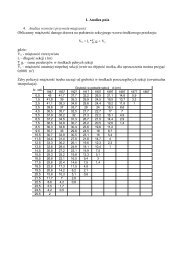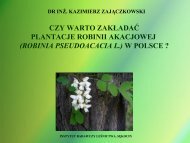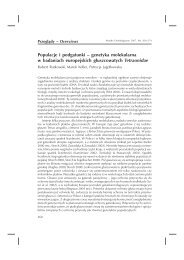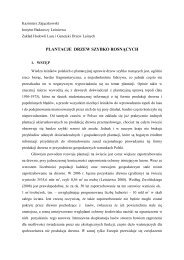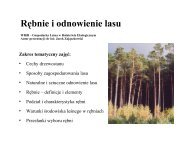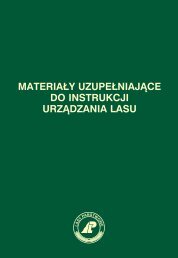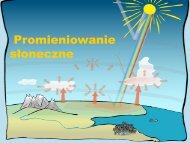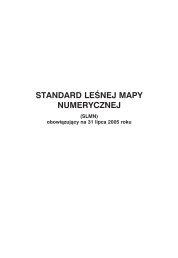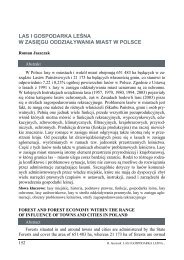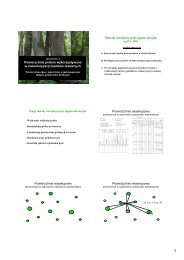Changes in the density and spatial distribution of red fox dens and ...
Changes in the density and spatial distribution of red fox dens and ...
Changes in the density and spatial distribution of red fox dens and ...
You also want an ePaper? Increase the reach of your titles
YUMPU automatically turns print PDFs into web optimized ePapers that Google loves.
Acta Theriologica 53 (2): 121–127, 2008.PL ISSN 0001–7051<strong>Changes</strong> <strong>in</strong> <strong>the</strong> <strong><strong>dens</strong>ity</strong> <strong>and</strong> <strong>spatial</strong> <strong>distribution</strong> <strong>of</strong> <strong>red</strong> <strong>fox</strong><strong>dens</strong> <strong>and</strong> cub numbers <strong>in</strong> central Pol<strong>and</strong> follow<strong>in</strong>g rabiesvacc<strong>in</strong>ationJacek GOSZCZYÑSKI, Magdalena MISIOROWSKA <strong>and</strong> Sebastian JUSZKOGoszczyñski J., Misiorowska M. <strong>and</strong> Juszko S. 2008. <strong>Changes</strong> <strong>in</strong> <strong>the</strong> <strong><strong>dens</strong>ity</strong><strong>and</strong> <strong>spatial</strong> <strong>distribution</strong> <strong>of</strong> <strong>red</strong> <strong>fox</strong> <strong>dens</strong> <strong>and</strong> cub numbers <strong>in</strong> central Pol<strong>and</strong>follow<strong>in</strong>g rabies vacc<strong>in</strong>ation. Acta Theriologica 53: 121–127.Increases <strong>in</strong> <strong>red</strong> <strong>fox</strong> Vulpes vulpes (L<strong>in</strong>naeus, 1758) numbers <strong>and</strong> <strong>dens</strong>itieshave been found <strong>in</strong> all European countries <strong>in</strong>volved <strong>in</strong> <strong>the</strong> rabies vacc<strong>in</strong>ationprogram. In Pol<strong>and</strong>, <strong>the</strong> number <strong>of</strong> <strong>fox</strong>es has <strong>in</strong>creased steadily s<strong>in</strong>ce <strong>the</strong>1990s. Between 1999–2000, <strong>the</strong> average <strong><strong>dens</strong>ity</strong> <strong>of</strong> <strong>fox</strong>es reached 1.3–2 <strong>in</strong>d./km 2<strong>in</strong> some parts <strong>of</strong> <strong>the</strong> country. The aim <strong>of</strong> <strong>the</strong> study was to estimate <strong>the</strong> change<strong>in</strong> <strong>fox</strong> population <strong>dens</strong>ities <strong>in</strong> central Pol<strong>and</strong> dur<strong>in</strong>g 1980–2006, <strong>and</strong> to assess<strong>the</strong> effect <strong>the</strong>se changes have had on <strong>the</strong> <strong>spatial</strong> <strong>distribution</strong> <strong>of</strong> natal <strong>dens</strong>,mean numbers <strong>of</strong> cubs observed at occupied <strong>dens</strong> <strong>and</strong> <strong>the</strong> sedentary/nomadic<strong>fox</strong> ratio. Estimations <strong>of</strong> <strong>fox</strong> population <strong><strong>dens</strong>ity</strong> <strong>and</strong> numbers were based onthree methods: (1) counts <strong>of</strong> tracks <strong>in</strong> snow, (2) locations <strong>of</strong> natal <strong>dens</strong> <strong>and</strong>counts <strong>of</strong> cubs, <strong>and</strong> (3) <strong>the</strong> battue (driv<strong>in</strong>g) method. The three methods <strong>of</strong>assessment were used cont<strong>in</strong>uously <strong>in</strong> our study area over a period <strong>of</strong> 25years. Average yearly results were analysed <strong>and</strong> comparisons made between<strong>the</strong> periods before <strong>and</strong> after implementation <strong>of</strong> <strong>the</strong> anti-rabies vacc<strong>in</strong>ation.The results obta<strong>in</strong>ed with all three methods show a significant <strong>in</strong>crease <strong>in</strong> <strong>the</strong><strong>fox</strong> population, when <strong>the</strong> two analysed periods are compa<strong>red</strong>. Increases <strong>in</strong> <strong>fox</strong>population <strong>dens</strong>ities correlated with <strong>in</strong>creased numbers <strong>of</strong> breed<strong>in</strong>g sitesbe<strong>in</strong>g located outside forests, from only s<strong>in</strong>gle ones <strong>in</strong> <strong>the</strong> 1980s to 24% <strong>of</strong> <strong>the</strong>total <strong>in</strong> 2005. The average number <strong>of</strong> cubs per occupied den decreased significantly(by 11%) <strong>in</strong> comparison with before <strong>the</strong> anti-rabies vacc<strong>in</strong>ationperiod. The great <strong>in</strong>crease (more than 100%) <strong>in</strong> <strong>fox</strong> numbers observed us<strong>in</strong>g<strong>the</strong> battue (driv<strong>in</strong>g) method suggest, that nomadic animals can form animportant part <strong>of</strong> w<strong>in</strong>ter population <strong>in</strong> our study area.Department <strong>of</strong> Forest Protection <strong>and</strong> Ecology, Warsaw University <strong>of</strong> Life Sciences, Warsaw, Pol<strong>and</strong>,Nowoursynowska 159 Str., 02-776 Warsaw, Pol<strong>and</strong>, e-mail: Magdalena.Misiorowska@wl.sggw.plKey words: Vulpes vulpes, <strong><strong>dens</strong>ity</strong>, <strong>distribution</strong> <strong>of</strong> breed<strong>in</strong>g <strong>dens</strong>, cub numbers,rabies vacc<strong>in</strong>ationIntroductionThe elim<strong>in</strong>ation <strong>of</strong> rabies via a nationwidevacc<strong>in</strong>ation program is likely to have major impactson <strong>the</strong> dynamics <strong>of</strong> <strong>red</strong> <strong>fox</strong> Vulpes vulpes(L<strong>in</strong>naeus, 1758) populations. An <strong>in</strong>crease <strong>in</strong> <strong>fox</strong>numbers <strong>and</strong> population <strong>dens</strong>ities has beenfound <strong>in</strong> all European countries participat<strong>in</strong>g <strong>in</strong>[121]
Response <strong>of</strong> <strong>red</strong> <strong>fox</strong> to rabies vacc<strong>in</strong>ation 1231. Count<strong>in</strong>g <strong>of</strong> tracks on snowIn w<strong>in</strong>ter, <strong>in</strong>dices <strong>of</strong> <strong>fox</strong> abundance were obta<strong>in</strong>ed fromsnow track<strong>in</strong>g conducted on transects. The first half <strong>of</strong>February, when mat<strong>in</strong>g season occurs, was excluded fromtrack<strong>in</strong>g. These transects were walked by observers with<strong>in</strong>1–2 days <strong>of</strong> new falls <strong>of</strong> snow. The <strong>in</strong>dex <strong>of</strong> <strong>fox</strong> <strong><strong>dens</strong>ity</strong> usedwas <strong>the</strong> number <strong>of</strong> <strong>fox</strong> trails cross<strong>in</strong>g 1 km <strong>of</strong> transect perday (n tracks/1 km/24 hrs) calculated as a mean for <strong>the</strong>w<strong>in</strong>ter season. The yearly mean length <strong>of</strong> transects <strong>in</strong> <strong>the</strong>first period (1979–1995) was 90 km <strong>and</strong> <strong>in</strong> <strong>the</strong> second(1996–2006) was 54.6 km.2. Estimation <strong>of</strong> natal <strong>dens</strong>At <strong>the</strong> beg<strong>in</strong>n<strong>in</strong>g <strong>of</strong> spr<strong>in</strong>g, an attempt was made to locateall <strong>dens</strong> present <strong>in</strong> <strong>the</strong> study area. Although <strong>the</strong> locations<strong>of</strong> <strong>the</strong> majority <strong>of</strong> <strong>dens</strong> were already known due toearlier <strong>in</strong>vestigations, several new <strong>dens</strong> were found everyyear. Information obta<strong>in</strong>ed from hunters, farmers <strong>and</strong> foresterswas also checked. The identification <strong>of</strong> natal <strong>dens</strong>was based on <strong>the</strong> presence <strong>of</strong> animal tracks at <strong>the</strong> entrances<strong>and</strong> <strong>in</strong> close proximity to burrows. O<strong>the</strong>r signs <strong>of</strong> animalpresence taken <strong>in</strong>to account were: carrion rema<strong>in</strong>s <strong>and</strong> remnants<strong>of</strong> prey, faeces <strong>of</strong> cubs <strong>and</strong> <strong>the</strong> typical odour. Thecounts <strong>of</strong> cubs were performed at natal <strong>dens</strong> <strong>in</strong> May <strong>and</strong>June. An attempt was made to observe <strong>dens</strong> for long enoughto count all cubs appear<strong>in</strong>g at <strong>the</strong> surface. If necessary, observationswere repeated over subsequent days. In case <strong>of</strong>absence <strong>of</strong> cubs <strong>in</strong> a den, irrespective <strong>of</strong> unquestionablesigns <strong>of</strong> animal presence, neighbor <strong>dens</strong> were also checkedto register <strong>the</strong> facts <strong>of</strong> carriage <strong>of</strong> young.3.ThebattuemethodIn late autumn (October, November) <strong>and</strong> early spr<strong>in</strong>g(March), driv<strong>in</strong>g censuses (aimed at estimat<strong>in</strong>g <strong>the</strong> <strong><strong>dens</strong>ity</strong><strong>of</strong> roe deer <strong>and</strong> hare populations) were undertaken <strong>in</strong> localforests by <strong>the</strong> staff <strong>of</strong> <strong>the</strong> Department <strong>of</strong> Zoology <strong>and</strong> GameManagement <strong>and</strong> students <strong>of</strong> Warsaw Agricultural University.Each forest compartment to be censused was surroundedby observers who stationed <strong>the</strong>mselves 50–100 mapart (to ma<strong>in</strong>ta<strong>in</strong> visual contact). The observers alongthree sides <strong>of</strong> an estimated compartment rema<strong>in</strong>ed stationary,while those along <strong>the</strong> fourth side moved <strong>in</strong>ward <strong>and</strong>went through <strong>the</strong> entire area. The observers (both stationary<strong>and</strong> mov<strong>in</strong>g) noted animals pass<strong>in</strong>g through <strong>the</strong> l<strong>in</strong>e <strong>of</strong>observers <strong>and</strong> <strong>the</strong> closed area be<strong>in</strong>g censused. This method<strong>of</strong> animal count<strong>in</strong>g excluded duplication <strong>of</strong> measurements(Pucek et al. 1975). Apart from hares <strong>and</strong> roe deer, <strong>the</strong> <strong>fox</strong>espresent <strong>in</strong> an area were also noted.The three methods <strong>of</strong> <strong>fox</strong> <strong><strong>dens</strong>ity</strong> assessment presentedhave been used cont<strong>in</strong>uously on our study area for <strong>the</strong> last25 years. Average yearly results were compa<strong>red</strong> between<strong>the</strong> periods before <strong>and</strong> after <strong>the</strong> anti-rabies vacc<strong>in</strong>ation programwas implemented.Student’s t-test <strong>and</strong> test for comparison <strong>of</strong> two percentages(Bailey 1995) were applied <strong>in</strong> statistical analyses.Results <strong>and</strong> discussionThe results obta<strong>in</strong>ed with all three studymethods showed a significant <strong>in</strong>crease <strong>in</strong> <strong>the</strong> <strong>fox</strong>population, when <strong>the</strong> two analysed periods wereTable 1. <strong>Changes</strong> <strong>in</strong> <strong><strong>dens</strong>ity</strong> <strong>in</strong>dices <strong>of</strong> <strong>the</strong> <strong>fox</strong> populations before (1980–1995) <strong>and</strong> after (1996–2005) <strong>the</strong> onset <strong>of</strong> <strong>the</strong> rabiesvacc<strong>in</strong>ation program, as calculated by <strong>the</strong> three different methods (Rogów, central Pol<strong>and</strong>). 1 – Goszczyñski 1989, J. Goszczyñski,unpubl.; 2 – Data from Department <strong>of</strong> Forest Protection <strong>and</strong> Ecology, Agricultural University <strong>of</strong> Warsaw; 3 –Goszczyñski 1989, Lach 1991; 4 – Jackowski 1999, Juszko 2005 <strong>and</strong> this paper.Mode <strong>of</strong> estimation <strong>and</strong> estimated areaParametersCompa<strong>red</strong> periods1980–1995 1996–2005tpSnow track<strong>in</strong>gs – whole terra<strong>in</strong> Number <strong>of</strong> seasons analyzed 14 7Total length <strong>of</strong> snow track<strong>in</strong>g (km) 1244.70 383.00Mean <strong><strong>dens</strong>ity</strong> (n tracks/km/24 hrs) 5.86 1 11.01 4.85 < 0.001SD 1.78 2.82Driv<strong>in</strong>g censuses – forests only Number <strong>of</strong> seasons analyzed 12 9Total surface <strong>of</strong> driv<strong>in</strong>g censuses (km 2 ) 21.04 29.87Mean <strong><strong>dens</strong>ity</strong> (n <strong>in</strong>ds./km 2 ) 1.22 2 2.58 2 2.86 < 0.05SD 1.08 1.28Number <strong>of</strong> <strong>dens</strong> with cubs – whole terra<strong>in</strong> Number <strong>of</strong> seasons analyzed 12 7Total number <strong>of</strong> <strong>dens</strong> with young 112 105Yearly mean <strong>of</strong> <strong>dens</strong> with young 9.33 3 15.00 4 4.41 < 0.001SD 1.70 3.55
124 J. Goszczyñski et al.50Before vacc<strong>in</strong>ationmean = 3.79, SD = 1.07, n = 5240301518Percentage <strong>of</strong> <strong>dens</strong> (%)2010050403061 2 3 4 5 6After vacc<strong>in</strong>ationmean = 3.39, SD = 0.99, n = 592219103208810021 2 3 4 5 6Number <strong>of</strong> cubs at denFig. 2. Change <strong>in</strong> number <strong>of</strong> young <strong>fox</strong>es observed at natal <strong>dens</strong> before (1980–1995) <strong>and</strong> after (1996–2005) rabies vacc<strong>in</strong>ationsprogram <strong>in</strong> Rogów (central Pol<strong>and</strong>). Figures above columns denote <strong>the</strong> number <strong>of</strong> observed litters with given numbers <strong>of</strong> cubs.compa<strong>red</strong>. The <strong>in</strong>crease <strong>in</strong> <strong>the</strong> snow track<strong>in</strong>g<strong>in</strong>dex was 88%, that <strong>in</strong> <strong>the</strong> average number<strong>of</strong> natal <strong>dens</strong> was 66%, <strong>and</strong> that <strong>in</strong> <strong>fox</strong> numberscounted with <strong>the</strong> battue method <strong>of</strong> 110%(Table 1).In <strong>the</strong> period after <strong>the</strong> anti-rabies vacc<strong>in</strong>ationprogram commenced, a decrease <strong>in</strong> <strong>the</strong> averagenumber <strong>of</strong> cubs per den was observed (Fig.2). The average number <strong>of</strong> cubs decreased significantlyby 11% (t = 2.03, df = 109, p < 0.05). Onlyoccasionally were litters with numerous cubsfound, <strong>and</strong> <strong>the</strong> numbers never exceeded five.This probably reflects <strong>in</strong>creased competitionamong pai<strong>red</strong> <strong>fox</strong>es for food <strong>and</strong> habitats. A decrease<strong>in</strong> reproductivity <strong>of</strong> <strong>fox</strong>es result<strong>in</strong>g from<strong>in</strong>creased <strong><strong>dens</strong>ity</strong> was also found by Voigt <strong>and</strong>Macdonald (1984).The <strong>in</strong>crease <strong>in</strong> <strong>fox</strong> population <strong><strong>dens</strong>ity</strong> correlatedwith numbers <strong>of</strong> breed<strong>in</strong>g <strong>dens</strong> locatedoutside forests. Before <strong>the</strong> vacc<strong>in</strong>ation programstarted, nearly all breed<strong>in</strong>g <strong>dens</strong> were <strong>in</strong> forests(with <strong>the</strong> exception <strong>of</strong> three out <strong>of</strong> 112). After <strong>the</strong>vacc<strong>in</strong>ation, <strong>the</strong> mean number <strong>of</strong> natal <strong>dens</strong>outside forests (<strong>in</strong> ab<strong>and</strong>oned gravel pits, haystacks,railway scarps <strong>and</strong> orchards) <strong>in</strong>creasedsignificantly to 13.3% <strong>of</strong> <strong>the</strong> total (t = 3.08,p < 0.01, test for comparison <strong>of</strong> two percentagesBailey 1995). This <strong>in</strong>crease cont<strong>in</strong>ued such that,
Response <strong>of</strong> <strong>red</strong> <strong>fox</strong> to rabies vacc<strong>in</strong>ation 125Table 2. Mean annual cull <strong>of</strong> <strong>red</strong> <strong>fox</strong>es <strong>in</strong> <strong>the</strong> study area <strong>and</strong> its vic<strong>in</strong>ity (2001–2005).Monitor<strong>in</strong>g districtArea (ha)Mean annual culln n/km 2Brzez<strong>in</strong>y 6000 11.8 0.20Regny 9000 34.4 0.38Cietrzew 8300 30.4 0.36Study area 8900 64.2 0.72<strong>in</strong> 2004–2005, 24% <strong>of</strong> all breed<strong>in</strong>g <strong>dens</strong> wereoutside forest (Misiorowska 2005). In Pol<strong>and</strong> at<strong>the</strong> turn <strong>of</strong> <strong>the</strong> 1970s, <strong>the</strong> percentage <strong>of</strong> <strong>fox</strong>breed<strong>in</strong>g <strong>dens</strong> located outside forest was low,even <strong>in</strong> territories with limited forest cover(Pielowski 1976, Goszczyñski 1985, Go³dyn et al.2003). However, by <strong>the</strong> end <strong>of</strong> <strong>the</strong> 1990s, <strong>in</strong> <strong>the</strong>Czempiñ area, (where <strong>the</strong> level <strong>of</strong> afforestationdoes not exceed 6%), almost 83% <strong>of</strong> breed<strong>in</strong>gsites were located outside <strong>the</strong> forest (Panek <strong>and</strong>Bresiñski 2002). In ano<strong>the</strong>r study, a high <strong><strong>dens</strong>ity</strong><strong>of</strong> <strong>fox</strong>es (2.2 <strong>in</strong>d./km 2 ) <strong>and</strong> a large number <strong>of</strong>natal <strong>dens</strong> were reported from a farml<strong>and</strong> area<strong>in</strong> Wielkopolska (Go³dyn et al. 2003). The <strong>in</strong>creaseduse <strong>of</strong> breed<strong>in</strong>g <strong>dens</strong> located <strong>in</strong> anagricultural l<strong>and</strong>scape may <strong>in</strong>dicate pr<strong>of</strong>oundchanges <strong>of</strong> habitat use by <strong>fox</strong>es, <strong>and</strong> adaptationto a human-modified environment (Bresiñski<strong>and</strong> Panek 2000, Tryjanowski 2000, Panek <strong>and</strong>Bresiñski 2002).Dur<strong>in</strong>g <strong>the</strong> last five years <strong>the</strong> average <strong>fox</strong>numbers at <strong>the</strong> beg<strong>in</strong>n<strong>in</strong>g <strong>of</strong> <strong>the</strong> hunt<strong>in</strong>g seasonwas approx. 80 <strong>in</strong>d. This number was estimatedon <strong>the</strong> basis <strong>of</strong> annual number <strong>of</strong> natal <strong>dens</strong> (15),mean number <strong>of</strong> cubs per den (3.4), <strong>and</strong> <strong>the</strong>number <strong>of</strong> adult <strong>fox</strong>es per occupied den (2). Thisvalue slightly exceeded an average annual hunt<strong>in</strong>gbag <strong>in</strong> <strong>the</strong> same period (approx. 64 per year).It could be expected that such a high hunt<strong>in</strong>gpressure resulted <strong>in</strong> a decrease <strong>in</strong> <strong>fox</strong> numbers<strong>and</strong> <strong><strong>dens</strong>ity</strong> <strong>in</strong> <strong>the</strong> follow<strong>in</strong>g year. However, <strong>in</strong>every subsequent w<strong>in</strong>ter, <strong>fox</strong> <strong><strong>dens</strong>ity</strong> rema<strong>in</strong>edstable or even <strong>in</strong>creased: from 12.7 tracks/km/24hrs to 13.49 <strong>in</strong> <strong>the</strong> 2000/2001 <strong>and</strong> 2004/2005hunt<strong>in</strong>g seasons respectively. Similarly, <strong>in</strong> everysubsequent spr<strong>in</strong>g, <strong>the</strong> number <strong>of</strong> occupied family<strong>dens</strong> showed an <strong>in</strong>creas<strong>in</strong>g trend (Misiorowska2005). This suggests that <strong>in</strong>truders fromneighborhood nearby formed an important part<strong>of</strong> <strong>the</strong> local population <strong>in</strong> our study area <strong>in</strong>autumn-w<strong>in</strong>ter. Probably, dur<strong>in</strong>g <strong>the</strong> autumn<strong>and</strong> w<strong>in</strong>ter, young <strong>fox</strong>es dispersed from adjo<strong>in</strong><strong>in</strong>gterra<strong>in</strong>s, where hunt<strong>in</strong>g pressure waslower (Table 2).Similar observations <strong>of</strong> compensation forpopulation wastage due to <strong>in</strong>tensive shoot<strong>in</strong>gwere described by Reynolds et al. (1993), Côté<strong>and</strong> Su<strong>the</strong>rl<strong>and</strong> (1997) <strong>and</strong> Vos (2003). Intruderslead a nomadic life, <strong>and</strong> use forests as naturalshelter dur<strong>in</strong>g <strong>the</strong> day. As a rule, <strong>the</strong>se <strong>fox</strong>escirculate around <strong>and</strong> <strong>in</strong>side occupied territories,not us<strong>in</strong>g exist<strong>in</strong>g, occupied <strong>dens</strong> as temporaryrefuges. In effect, some <strong>of</strong> <strong>the</strong>se animals stayabove ground dur<strong>in</strong>g <strong>the</strong> day. The results with<strong>the</strong> battue (driv<strong>in</strong>g) method applied <strong>in</strong> forestconfirm this suggestion: <strong>the</strong> greatest <strong>in</strong>crease <strong>in</strong><strong>fox</strong> numbers, <strong>of</strong> more than 100%, was found forthis. The battue method is <strong>the</strong> best <strong>of</strong> <strong>the</strong> threeused to assess numbers <strong>of</strong> nomadic animals. Incases <strong>of</strong> high <strong>fox</strong> mortality (eg with <strong>in</strong>tensiveshoot<strong>in</strong>g), some nomadic animals eventually occupyvacated territories <strong>and</strong> stabilize <strong>the</strong> wholepopulation (Jasja et al. 2001, Vos 2003).Our results may also have practical implicationsfor hunt<strong>in</strong>g management. An <strong>in</strong>creased <strong>fox</strong>popuation is regarded as <strong>the</strong> ma<strong>in</strong> reason for <strong>the</strong>decrease <strong>in</strong> small game populations (Panek et al.2006). However, <strong>the</strong> successful <strong>red</strong>uction <strong>of</strong> <strong>the</strong><strong>fox</strong> population over areas cover<strong>in</strong>g only severaldozen square kilometres, as <strong>in</strong> case <strong>of</strong> our studyarea, is not possible, if shoot<strong>in</strong>g pressure on adjo<strong>in</strong><strong>in</strong>gareas is low. From a game managementpo<strong>in</strong>t <strong>of</strong> view, <strong>the</strong> goal should <strong>the</strong>refore lie <strong>in</strong> an<strong>in</strong>tensive <strong>and</strong> coord<strong>in</strong>ated <strong>in</strong>crease <strong>in</strong> <strong>fox</strong> cull<strong>in</strong>g
126 J. Goszczyñski et al.<strong>in</strong> areas <strong>of</strong> at least several hund<strong>red</strong>s, or severalthous<strong>and</strong>s, <strong>of</strong> square kilometres. This is especiallyimportant on account <strong>of</strong> <strong>the</strong> high dispersionrange <strong>of</strong> young <strong>fox</strong>es, even exceed<strong>in</strong>g severaldozen kilometres (Zimen 1984, Trewhella et al.1988, Allen <strong>and</strong> Sargeant 1993).Acknowledgements: The English version <strong>of</strong> <strong>the</strong> text was revisedby J. Richards.ReferencesAllen S. H. <strong>and</strong> Sargeant A. B. 1993. Dispersal patterns <strong>of</strong><strong>red</strong> <strong>fox</strong>es relative to population <strong><strong>dens</strong>ity</strong>. The Journal <strong>of</strong>Wildlife Management 57: 526–533.Aubert M., Vuillaume P. <strong>and</strong> Masson E. 1993. La vacc<strong>in</strong>ationorale des renards est efficace mme qu<strong>and</strong> leurspopulations augmentent. Bullet<strong>in</strong> épidémiologique de larage animale en France 23: 1–4.Bailey N. T. J. 1995. Statistical methods <strong>in</strong> biology. CambridgeUniversity Press, Cambridge: 1–200.Breitenmoser U., Müller U., Kappeler A. <strong>and</strong> Zanoni R. G.2000. Die Endphase der Tollwut <strong>in</strong> der Schweiz. SchweizerArchiv fur Tierheilkunde 142: 447–457.Bresiñski W. <strong>and</strong> Panek M. 2000. [The condition <strong>of</strong> <strong>the</strong> <strong>fox</strong>population <strong>in</strong> Pol<strong>and</strong> at <strong>the</strong> end <strong>of</strong> <strong>the</strong> n<strong>in</strong>eties (monitor<strong>in</strong>gresults)]. [In: Zwierzyna drobna jako element bioró¿norodnoœciœrodowiska przyrodniczego. Materia³y IIKrajowej Konferencji, W³oc³awek, 7–9.09.2000. S. Kubiak,ed]. W³oc³awskie Towarzystwo Naukowe, W³oc³awek:163–171. [In Polish]Chautan M., Portier D. <strong>and</strong> Artois M. 2000. Role <strong>of</strong> rabies<strong>in</strong> recent demographic changes <strong>in</strong> <strong>red</strong> <strong>fox</strong> (Vulpesvulpes) populations <strong>in</strong> Europe. Mammalia 64: 391–410.Contesse P., Heggl<strong>in</strong> D., Gloor S., Bontad<strong>in</strong>a F. <strong>and</strong>Deplazes P. 2004. The diet <strong>of</strong> urban <strong>fox</strong>es (Vulpes vulpes)<strong>and</strong> <strong>the</strong> availability <strong>of</strong> anthropogenic food <strong>in</strong> <strong>the</strong>city <strong>of</strong> Zurich, Switzerl<strong>and</strong>. Mammalian Biology 69:81–95.Côté I. M. <strong>and</strong> Su<strong>the</strong>rl<strong>and</strong> W. J. 1997. The effectives <strong>of</strong> remov<strong>in</strong>gp<strong>red</strong>ators to protect bird populations. ConservationBiology 11: 395–405.Dudziñski W. 1988. W<strong>in</strong>ter<strong>in</strong>g grounds <strong>of</strong> <strong>the</strong> partridge. [In:The grey partridge <strong>in</strong> Europe. Proceed<strong>in</strong>gs <strong>of</strong> an InternationalSymposium held <strong>in</strong> Kikol, Pol<strong>and</strong>, October1985]. Polish Hunt<strong>in</strong>g Association, Warsaw: 161–197.Dziêcio³owski R., Wasilewski M., Przypaœniak J. <strong>and</strong> WawrzyniakP. 1999. Recent changes <strong>in</strong> European hare (Lepuseuropaeus) population dynamics <strong>in</strong> Pol<strong>and</strong>. [In:Proceed<strong>in</strong>gs <strong>of</strong> <strong>the</strong> International Union <strong>of</strong> Game Biologists.XXIVth Congress, C. Thomaidis <strong>and</strong> N. Kypridemos,eds]. Hunt<strong>in</strong>g <strong>and</strong> Target Shoot<strong>in</strong>g Magaz<strong>in</strong>e, Gundogs<strong>and</strong> Hunt<strong>in</strong>g Magaz<strong>in</strong>e: 401–408.GloorS.,Bontad<strong>in</strong>aF.,Heggl<strong>in</strong>D.,DeplazesP.<strong>and</strong>BreitenmoserU. 2001. The rise <strong>of</strong> urban <strong>fox</strong> populations <strong>in</strong>Switzerl<strong>and</strong>. Mammalian Biology 66: 155–164.Go³dynB.,HromadaM.,SurmackiA.<strong>and</strong>TryjanowskiP.2003. Habitat use <strong>and</strong> diet <strong>of</strong> <strong>the</strong> <strong>red</strong> <strong>fox</strong> Vulpes vulpes<strong>in</strong> an agricultural l<strong>and</strong>scape <strong>in</strong> Pol<strong>and</strong>. Zeitschrift fürJagdwissenschaft 49: 191–200.Goszczyñski J. 1985. The effect <strong>of</strong> structural differentiation<strong>of</strong> an ecological l<strong>and</strong>scape on p<strong>red</strong>ator-prey <strong>in</strong>teractions.Treatises <strong>and</strong> Monographs. SGGW-AR, Warsaw 46:1–80. [In Polish with English summary]Goszczyñski J. 1989. Population dynamics <strong>of</strong> <strong>the</strong> <strong>red</strong> <strong>fox</strong> <strong>in</strong>central Pol<strong>and</strong>. Acta Theriologica 34: 141–154.Harris S. <strong>and</strong> Rayner J. M. V. 1986. Urban <strong>fox</strong> (Vulpesvulpes) population, estimates <strong>and</strong> habitat requirements<strong>in</strong> several British cities. Journal <strong>of</strong> Animal Ecology 55:575–591.H<strong>of</strong>er S., Gloor S., Müller U., Mathies A., Heggl<strong>in</strong> D. <strong>and</strong>Deplazes P. 2000. High prevalence <strong>of</strong> Ech<strong>in</strong>ococcusmultilocularis <strong>in</strong> urban <strong>red</strong> <strong>fox</strong>es (Vulpes vulpes) <strong>and</strong>voles (Arvicola terrestris) <strong>in</strong> <strong>the</strong> city <strong>of</strong> Zürich, Switzerl<strong>and</strong>.Parasitology 120: 135–142.Holmala K. <strong>and</strong> Kauhala K. 2006. Ecology <strong>of</strong> wildlife rabies<strong>in</strong> Europe. Mammal Review 36: 17–36.Jackowski M. 1999. [Numbers, <strong><strong>dens</strong>ity</strong> <strong>and</strong> <strong>spatial</strong> <strong>distribution</strong><strong>of</strong> <strong>the</strong> <strong>red</strong> <strong>fox</strong> <strong>and</strong> badger <strong>in</strong> Rogów]. MSc <strong>the</strong>sis,Department <strong>of</strong> Forest Protection <strong>and</strong> Ecology, WarsawAgricultural University, Warsaw: 1–36. [In Polish]JasjaJ.A.,DekkerJ.J.A.,Ste<strong>in</strong>A.<strong>and</strong>Heitkön<strong>in</strong>gI.M.A.2001. A <strong>spatial</strong> analysis <strong>of</strong> <strong>the</strong> population <strong>of</strong> <strong>the</strong> <strong>red</strong> <strong>fox</strong>(Vulpes vulpes) <strong>in</strong> <strong>the</strong> Dutch coastal dune area. Journal<strong>of</strong> Zoology, London 255: 505–510.Juszko S. 2005. [The impact <strong>of</strong> p<strong>red</strong>ation on brown haremortality <strong>in</strong> central Pol<strong>and</strong>]. PhD <strong>the</strong>sis, Department <strong>of</strong>Forest Protection <strong>and</strong> Ecology, Warsaw AgriculturalUniversity, Warsaw: 1–81. [In Polish]Lach M. 1991. [Reproduction <strong>and</strong> <strong><strong>dens</strong>ity</strong> <strong>of</strong> <strong>the</strong> <strong>red</strong> <strong>fox</strong> <strong>in</strong><strong>the</strong> Rogów area]. MSc <strong>the</strong>sis, Department <strong>of</strong> Game Management<strong>and</strong> Forest Zoology, Warsaw Agricultural University,Warsaw: 1– 35. [In Polish]Kamieniarz R. 2006. [Do <strong>fox</strong> kill roe deer?]. £owiec Polski 6:20–22. [In Polish]Kauhala K., Holmala K., Lammers W. <strong>and</strong> Schregel J. 2006.Home ranges <strong>and</strong> <strong>dens</strong>ities <strong>of</strong> medium-sized carnivores<strong>in</strong> south-east F<strong>in</strong>l<strong>and</strong>, with special reference to rabiesspread. Acta Theriologica 51: 1–13.König A. 2008. Fears, attitudes <strong>and</strong> op<strong>in</strong>ions <strong>of</strong> suburbanresidents with regards to <strong>the</strong>ir urban <strong>fox</strong>es. EuropeanJournal <strong>of</strong> Wildlife Research 54: 101–109.Misiorowska M. 2005. [Red <strong>fox</strong> (Vulpes vulpes) number <strong>and</strong><strong>spatial</strong> <strong>distribution</strong> <strong>in</strong> LZD Rogów area]. MSc <strong>the</strong>sis,Department <strong>of</strong> Forest Protection <strong>and</strong> Ecology, WarsawAgricultural University, Warsaw: 1–57. [In Polish]Panek M. <strong>and</strong> Bresiñski W. 2002. Red <strong>fox</strong> Vulpes vulpes<strong><strong>dens</strong>ity</strong> <strong>and</strong> habitat use <strong>in</strong> a rural area <strong>of</strong> western Pol<strong>and</strong>at <strong>the</strong> end <strong>of</strong> <strong>the</strong> 1990s, compa<strong>red</strong> with <strong>the</strong> turn <strong>of</strong><strong>the</strong> 1970s. Acta Theriologica 47: 433–442.Panek M., Kamieniarz R. <strong>and</strong> Bresiñski W. 2006. The effect<strong>of</strong> experimental removal <strong>of</strong> <strong>red</strong> <strong>fox</strong>es Vulpes vulpes on<strong>the</strong> spr<strong>in</strong>g <strong><strong>dens</strong>ity</strong> <strong>of</strong> brown hares Lepus europaeus <strong>in</strong>western Pol<strong>and</strong>. Acta Theriologica 51: 187–193.
Response <strong>of</strong> <strong>red</strong> <strong>fox</strong> to rabies vacc<strong>in</strong>ation 127Pielowski Z. 1976. The role <strong>of</strong> <strong>fox</strong>es <strong>in</strong> <strong>the</strong> <strong>red</strong>uction <strong>of</strong> <strong>the</strong>European hare population. [In: Ecology <strong>and</strong> management<strong>of</strong> European hare populations. Z. Pielowski <strong>and</strong> Z.Pucek, eds]. Pañstwowe Wydawnictwo Rolnicze i Leœne,Warszawa: 135–148.Pucek Z., Bobek B., £abucki L., Mi³kowski L., Morow K.<strong>and</strong> Tomek A. 1975. Estimates <strong>of</strong> <strong><strong>dens</strong>ity</strong> <strong>and</strong> number <strong>of</strong>ungulates. Polish Ecological Studies 1: 121–136.Reynolds J. C., Goddard H. N. <strong>and</strong> Brockless M. H. 1993.The impact <strong>of</strong> local <strong>fox</strong> (Vulpes vulpes) removal on <strong>fox</strong>population at two sites <strong>in</strong> sou<strong>the</strong>rn Engl<strong>and</strong>. Giber FauneSauvage 10: 319–334.Saunders G., White P. C. L. <strong>and</strong> Harris S. 1997. Habitatutilisation by urban <strong>fox</strong>es (Vulpes vulpes) <strong>and</strong><strong>the</strong>implicationsfor rabies control. Mammalia 61: 497–510.Trewhella W. J., Harris S. <strong>and</strong> McAllister F. E. 1988. Dispersaldistance, home range size <strong>and</strong> population <strong><strong>dens</strong>ity</strong><strong>in</strong> <strong>the</strong> <strong>red</strong> <strong>fox</strong> (Vulpes vulpes): a quantitative analysis.Journal <strong>of</strong> Applied Ecology 25: 423–434.Tryjanowski P. 2000. <strong>Changes</strong> <strong>in</strong> breed<strong>in</strong>g bird populations<strong>of</strong> some farml<strong>and</strong> birds <strong>in</strong> W. Pol<strong>and</strong> <strong>in</strong> relation tochanges <strong>in</strong> crop structure, wea<strong>the</strong>r conditions <strong>and</strong> number<strong>of</strong> p<strong>red</strong>ators. Folia Zoologica 49: 305–315.Voigt D. R. <strong>and</strong> Macdonald D. W. 1984. Variation <strong>in</strong> <strong>the</strong><strong>spatial</strong> <strong>and</strong> social behaviour <strong>of</strong> <strong>the</strong> <strong>red</strong> <strong>fox</strong>, Vulpesvulpes. Acta Zoologica Fennica 171: 261–265.Vos A. C. 1995. Population dynamics o <strong>the</strong> <strong>red</strong> <strong>fox</strong> (Vulpesvulpes) after <strong>the</strong> disappearance <strong>of</strong> rabies <strong>in</strong> countyGarmisch-Partenkirchen, Germany, 1987–1992. AnnalesZoologici Fennici 32: 93–97.Vos A. C. 2003. Oral vacc<strong>in</strong>ation aga<strong>in</strong>st rabies <strong>and</strong> behaviouralecology <strong>of</strong> <strong>the</strong> <strong>red</strong> <strong>fox</strong> (Vulpes vulpes). Journal <strong>of</strong>Veter<strong>in</strong>ary Medic<strong>in</strong>e, Series B 50: 477–483.Wasilewski M. 1986. Population dynamics <strong>of</strong> pheasants nearRogów, Central Pol<strong>and</strong>. Ekologia Polska 34: 669–680.Wasilewski M. 1991. Population dynamics <strong>of</strong> <strong>the</strong> Europeanhare Lepus europaeus Pallas, 1778 <strong>in</strong> Central Pol<strong>and</strong>.Acta Theriologica 36: 267–274.Zimen E. 1984. Long range movements <strong>of</strong> <strong>the</strong> <strong>red</strong> <strong>fox</strong>,Vulpes vulpes L. Acta Zoologica Fennica 171: 267–270.Received 9 November 2007, accepted 19 March 2008.Asscociate editor was Andrzej Zalewski.



